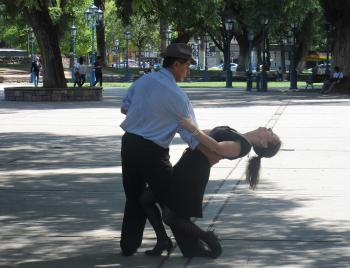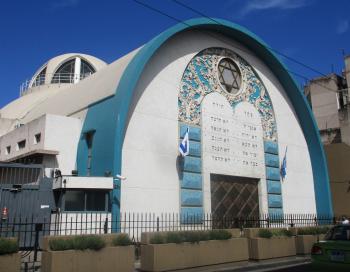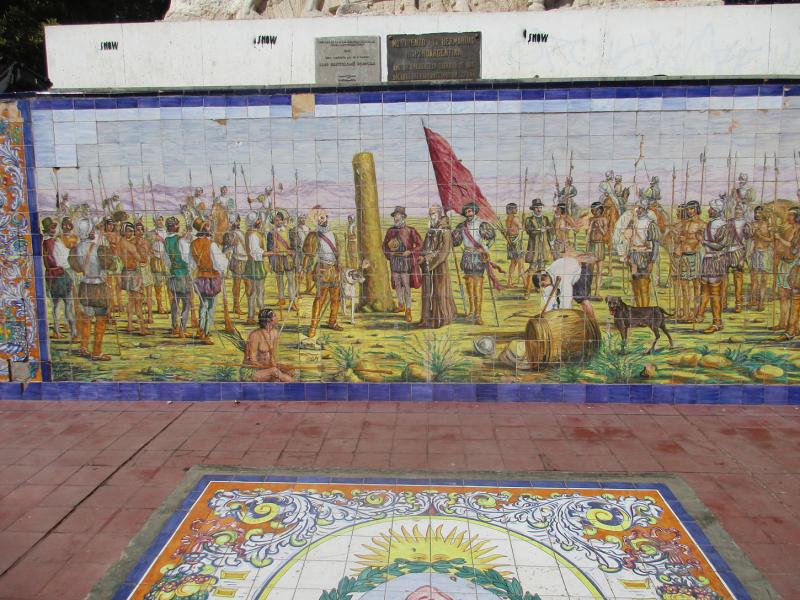Spontaneous adventures in Argentina
This article appears on page 42 of the October 2016 issue.
For our spring 2016 travels, we set aside five weeks in March and April. In light of increasing reports of security problems in Europe, we looked south to Argentina and Chile.
We’re independent travelers, so before leaving home we booked only our flights to Buenos Aires and our return flights from Santiago back to Florida, together with a 3-night hotel stay in Buenos Aires. Along the way, we waited until the last minute to make travel decisions in order to give ourselves maximum flexibility, booking flights and accommodations on the Internet according to our whims.
Buenos Aires
As it had been almost 20 years since we visited Buenos Aires, we felt it was time to return. Following a marathon 3-flight (24-hour) journey with LAN (Orlando-Lima-Santiago-Buenos Aires), we were back in BA. (By the way, after we returned from this trip, we learned from an ITN article that a week after we arrived in Argentina, the country eliminated its $160-per-person reciprocity fee.)
Argentina had been through hard times, economically, since our last visit, and we noticed the effects. The new government has imposed strict rules, including not allowing the withdrawal of more than the equivalent of about $65 at one time (with high fees) from bank ATMs. This was a challenge for us on arrival at BA’s convenient-to-downtown Aeroparque Jorge Newbery, but after learning how to “work the system” (we each had an ATM card in our name and made individual withdrawals), we were able to get double that amount of local currency.
Carole was very proud of herself in negotiating a taxi for half the initially requested rate for a ride from the airport to the comfortable, well-located El Conquistador Hotel (Suipacha 948; elconquistador.com.ar), where our double room cost about $75 a night, including a substantial buffet breakfast.
After a quick look around the neighborhood, we came across a traditional old-world restaurant just a couple of blocks from our hotel, where waiters in formal attire presented us local dishes (Patagonian salmon and a “panache” of cooked veggies) with the lost art of silver service for a total of less than $20.
We took in most of this sprawling city by public bus and subway, traveling with the locals, which was both convenient and easy.
In Puerto Madero, a formerly neglected port area, there were huge, modern, glistening skyscrapers with trendy waterfront shops and outdoor cafés. Throughout the city, we discovered many elegant, European-style monuments and grand edifices.
However, BA is full of dilapidated old buildings as well, many of which are in need of painting, renovating and cleaning. Homeless people sleep in parks, office-building alcoves and on sidewalks and often beg near the doors of churches.
One of the first stops we made was the Metropolitan Cathedral, the church of Pope Francis, BA’s famous native son. There, the Pope was once priest, archbishop and cardinal.
The tomb of national hero General San Martín is located inside, and we happened to be there while guards in formal military attire paid homage.
Of course, we couldn’t go to BA without taking in a tango show, and we did this twice — once at the historic, elegant Café Tortoni (Av. de Mayo 825), where we were impressed with the staging and exotic costumes of talented and beautiful dancers, and next in the colorful barrio (neighborhood) of La Boca, where we enjoyed lunch while being entertained by street dancers.
We concluded our BA stay by returning to the magnificent Libertad Synagogue, where we attended Friday night services as we had done on our first visit there.
Bariloche
It was time to leave the big city to explore more of Argentina, and we chose Bariloche, two hours away by air, as our first stop. It is in the heart of Argentina’s Lake District, an alpine region that reminded us of the Canadian Rockies and the mountains of Switzerland, Austria and Germany as well as Chile’s Lake District.
On the Internet, we found the delightful Kospi Boutique Guesthouse (Mitre 1361, San Carlos de Bariloche) for about $50 a night, including breakfast.
Bariloche is Argentina’s chocolate capital, and it provided endless temptations. We also saw many people consuming massive beef steaks, for which Argentina is famous, but we delighted in superb fresh trout, found in the many nearby lakes.
A gorgeous city year-round, Bariloche is located in a lakeside setting within Nahuel Huapi National Park. We loved being there in early autumn to enjoy the pristine scenery, clear blue skies, warm days and cool evenings along with superb gardens and parks filled with giant, colorful roses.
Initially, we avoided organized tours and escaped the crowds by independently exploring the stunning Circuito Chico (Little Circuit) by public transport. This gave us a brief introduction to some of Argentina’s most spectacular areas. (In fact, as we drafted this part of our article, we were sitting on the terrace of the luxurious, 5 star Llao Llao Resort (Av. Ezequiel Bustillo Km. 25; llaollao.
com) indulging in a fabulous, decadently chocolate-laden afternoon tea while enjoying the view of the snowcapped mountains and majestic, tranquil Lake Moreno. What an experience!)
A must-do all-day excursion took us on the Route of the Seven Lakes. Crossing savannas and passing forests of beech, cypress and pine trees and then pampas and mountains, we entered the lake area, formed years ago into fjords, and continued through two national parks. The stunning views of the deep, bright-blue moraine lakes and walks through tiny alpine villages were delightful.
Córdoba
From Bariloche, in the southern half of Argentina, we flew to Córdoba, to the north. From a quiet, lakeside town to Argentina’s bustling, second-largest city — what a contrast!
Córdoba has done an excellent job restoring the legacy of its Spanish colonial past with beautifully maintained classical museums, universities, libraries and churches.
One of the most interesting sites was a crypt built hundreds of years ago by the Jesuits. After they were expelled from the country, the site was demolished and buried over. In 1989, when the telephone company was laying underground cable, they ran into it, and the city of Córdoba lovingly restored this treasure, now used for theatrical performances and exhibits.
In beautiful Indian-summer weather, we continued exploring Córdoba’s colonial past, taking in the UNESCO World Heritage-listed Jesuit Quarter, an enormous block featuring the cloistered 17th-century University of Córdoba, a magnificent Jesuit church and Monserrat Jesuit College.
In contrast, within the city center’s colonial area were stark reminders of Argentina’s more recent history. In one charming, cobblestoned street, hundreds of white pennants with pictures of individuals represented the tens of thousands of alleged left-wing activists who “disappeared” during Argentina’s so-called Dirty War, when the military government tried to eradicate dissent. Nearby, Argentine veterans of the disastrous Falklands (Malvinas) War of 1982 peacefully protested their lack of compensation by the government. All was quite somber.
That evening, we (safely) watched a huge, raucous parade of all kinds of protesters passing through the city center to commemorate the 40th anniversary of the “disappeared.” And, on a Friday night, we visited Córdoba’s Templo Beit Israel to attend Kabbalat Shabbat services. We were warmly welcomed in the large, beautiful synagogue and were touched when the names of the Jewish “disappeared” were read out in a remembrance ceremony.
On a happier note, we randomly hopped onto city buses (which offered onboard entertainment provided by different vendors) that took us out to working-class barrios, leafy middle-class suburbs, funky bohemian neighborhoods, a modern shopping mall and upscale New Córdoba, with its chic cafés, restaurants and elegant museums.
Mendoza
For our final stop in Argentina, we chose Mendoza, the heart of Argentina’s wine country. Surrounded by a desert landscape, there is more to Mendoza than its famous Malbec wine industry. This lovely, bustling-yet-somehow-relaxed city boasts beautiful fountain- and flower-filled plazas, leafy boulevards, cosmopolitan cafés and friendly, helpful locals.
We stayed at Hotel Mendoza (Av. España 1210) for about $75 per night, including breakfast. From our hotel’s 10th floor breakfast terrace, we could see the magnificent, snowcapped Andes Mountains that divide the countries of Argentina and Chile.
It’s no wonder Mendoza is synonymous with wine. The (mostly) Malbec wine from the many wineries of the Maipú region, situated just outside town, is world class, so we had to take a winery tour!
We visited two boutique wineries, where we were shown vineyards and the areas where the grapes were processed.
Tastings followed. The Malbec reserve from Domiciano de Barrancas bodega was our favorite.
After the wineries tour, we visited the Pasrai olive oil farm for more edification and tasting. Finally, a stop at the church of the patron saint of the wine industry completed our fascinating afternoon.
We booked this winery tour through our hotel. Operated by Mancagua Viajes, the tour cost ARS340 (near $23) per person.
To round out our Mendoza stay, we took a (wild!) public bus ride, the driver speeding to the lovely village of Chacras de Coria on the city’s outskirts. After looking around, we happened on a tiny, family-owned bodega, where we enjoyed a delicious lunch in a rustic setting under grapevines.
This was our last meal of the famous Argentine beef, cooked over an Argentine-style barbecue, before we headed over the Andes Mountains to Chile.
Next month, the Feldmans continue their travel tale as their journey takes them to Chile.




